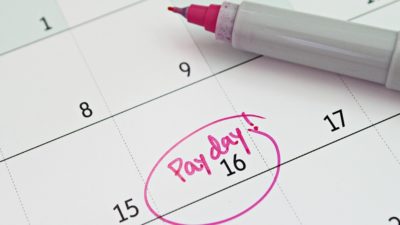By Dave Van Geem
Davis + Henderson (TSX:DH) has been trending in the newsfeeds lately. D+H is trading at near three-year highs and has a yield approaching 5%. In the first part of this two-part mini-series, I explored revenue streams and acquisition strategies. Now let’s zero in on valuation and see if this company deserves a spot in your dividend portfolio.
The formula for a good dividend payer isn’t complicated — it boils down to the essentials:
- Yield (increasing, decreasing, or stable)
- Balance sheet (adequate working capital)
- Cash flow (ability to pay)
Yield
D+H is currently yielding 4.78% on a dividend of $1.28 as of the time of this writing. D+H converted from an income trust to a corporation 31 December 2010. Over the past 11 quarters the dividend has increased three times, from $0.15 to $0.32.
| Dividend Payments | FY 2012 | FY 2012 | FY 2011 |
| Q1 | $0.32 | $0.31 | $0.15 |
| Q2 | $0.32 | $0.31 | $0.30 |
| Q3 | $0.32 | $0.31 | $0.31 |
| Q4 | $0.32 | $0.31 |
Source: Google Finance
D+H management remains firmly committed to the existing $1.28 dividend payout and estimates a 78% payout ratio on adjusted net income for the combined entity. A total of 21.5 million new shares were issued last month (along with the possibility of exercise in the convertible bond issue), on top of 59.2 million existing shares on August 13.
Balance sheet
Increasing dividends are great, but not if they come at the expense of strangling the future of the company by shortchanging capital investment and leaving the executive team unable to meet day-to-day expenses. One way to monitor this is through changes in working capital.
| Working Capital | FY 2012 | FY 2011 | FY 2010 |
| Current Assets | $109.0 | $99.9 | $78.6 |
| – Current Liabilities | $113.2 | $106.8 | $106.4 |
| = Working Capital | ($4.2) | ($6.9) | ($27.8) |
Source: D+H Annual Statements, $millions
The working capital is improving but is firmly negative. This isn’t always a bad sign – especially in a service-based business where inventories are minimal. Dividend investors generally frown on negative working capital ratios and it is something to watch very closely.
Cash flow
D+H almost doubled in size with the acquisition of Harland back in August. The issuing of new shares and added debt makes historic cash flows almost meaningless. The combined entity is what is important and at the moment there are no audited public financials available for the new company.
What investors do know based on public statements and the announced financing arrangement is that long-term debt has grown an additional $600 million. Management announced the debt-to-EBITDA will grow to 3.4 times as a result of the close of the deal. It seems D+H recognizes the financial stretch and has promised to pay down debt. “We believe leverage will be reduced to less than 2.5 times by 2016,” CFO Brian Kyle said in a conference call in July.
The bottom line
Mergers carry risks. Doubling the size of a company carries big risks. Academics put the failure rate on acquisitions of any size at higher than 7 in 10. Up to this point, D+H has shown an ability to smoothly integrate acquisitions while executing on its core competency of helping financial institutions with mission-critical business systems. Its “software as a service” (SaaS) model creates sticky customers and the company’s recent purchases open up exciting cross-selling opportunities that are easily scalable and very profitable.
On the other hand, D+H has swung for the fences with the Harland acquisition. Harland nearly doubles the size of the company and is five times bigger than its next biggest acquisition. Add to that a very high payout ratio and a stock price within a few percent of its 52-week high and D+H stays on the watch list for now.
The Motley Fool’s top two stock ideas
The Motley Fool Canada’s senior investment analyst recently unveiled his top two stock ideas for new money now. And YOU can be one of the first to read his buy reports — just click here for all the details.
Disclosure: At the time of publication, Dave Van Geem had no positions in the companies mentioned.







